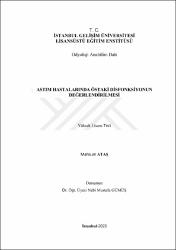| dc.contributor.author | Ataş, Mahsum | |
| dc.date.accessioned | 2024-02-21T19:43:43Z | |
| dc.date.available | 2024-02-21T19:43:43Z | |
| dc.date.issued | 2023 | en_US |
| dc.identifier.uri | https://hdl.handle.net/11363/7072 | |
| dc.description | Danışman: DR. ÖĞR. ÜYESİ NEBİ MUSTAFA GÜMÜŞ
Yer Bilgisi: İstanbul Gelişim Üniversitesi / Lisansüstü Eğitim Enstitüsü / Odyoloji Ana Bilim Dalı / Odyoloji Bilim Dalı
Konu: Kulak Burun ve Boğaz = Otorhinolaryngology (Ear-Nose-Throat) | en_US |
| dc.description.abstract | Bu araştırmada temel amacımız, astım hastalığı bulunan kişilerin zamanla östaki
disfonksiyonu olup olmadığını gözlemlemektir.
Bu çalışma Van eğitim araştırma hastanesinde göğüs tüm şikayetleri ile hastalıkları
polikliniğine astım semptomları için başvurup yapılan klinik muayenede astım tanısı
olan hastalara odyoloji kliniğinde akustik immitansmetri ve östaki fonksiyon testleri
uygulanmıştır.
26 kadın 14 erkek kişinin katıldığı çalışmamız da cinsiyet dağılımları bakımından
gruplar arası fark istatistiksel olarak anlamlı bulunmuştur (p=0,014). Kontrol
grubunda erkek oranı (%62,5) hasta grubu oranına (%35,0) göre anlamlı yüksektir.
Yaş değişkeni bakımından grup ortalamaları bakımından (Hasta grubu: 40,6±14,77
ve Kontrol grubu: 36.68±11,49) istatistiksel olarak anlamlı farklılık yoktur
(p=0,189).
ETDQ7 skoru bakımından grup ortalamaları arasında istatistiksel olarak anlamlı fark
bulunmuştur (p=0,003). Hasta grup ortalaması (14,58±7,11) kontrol grubu
ortalamasından (10,68±3,22) istatistiksel olarak anlamlı yüksek bulunmuştur.
Sonuç olarak
; EFT değerlendirmesi bakımından gruplardaki disfonksiyon dağılımları arası fark
istatistiksel olarak anlamlı değildir. | en_US |
| dc.description.abstract | Our main purpose in this research is to investigate the experiences and satisfaction of
various ear molds (hard mold, soft mold) in elderly patients, which play an important
role in patients with hearing loss.
The study was carried out in patients who had hearing problems at high frequencies
and who also had to use a hearing aid for more than 3 months.
Ear molds were collected for sample purposes from patients who did not have
hearing problems. Mold types were made from these ear molds as intermediate level
(hybrid), hard and soft. In order to make these comparisons, some necessary tests had
to be provided. These are the tests expressed with the names of real ear gain (GKK),
true occlusion gain in the ear (GOKC) and real gain of the ear (GCC) in those with
devices.
The comparison of these patterns with each other was based on, and the patterns
were tested, and a reversible test was given to the subjects for the comfort of these
patterns. When the differences were examined, it was seen that there were no
significant differences in these 3 earmold types in terms of gain. However, it was
observed that the softer mold and the medium hard mold created a feeling of fullness
in the ear compared to the other type. In terms of comfort, it was understood that it
was better than the hard mold.
While the subjects using the device were taking the test, their devices were first
removed and tested, then after they were put on, the audiological test was performed
again and it was revealed that there were serious differences between them. It was
seen that it was in the target of SSPC in low-voiced frequencies, and this value
increased in average patterns. It was not possible to reach the desired values at
medium frequencies such as 4000 Hz and 6000 Hz. In the unplugged test, it was
observed that the GYMA (Satisfaction with Amplification in Daily Life
Questionnaire) and ICPA (hearing aid performance questionnaire) values were
higher. In addition, these results showed that the standard molded hearing aid was used for much longer periods of time. In the unplugged scenario, it is understood that
there is a parallel connection in the ICPA results and device usage time.
The aim of the research is to investigate and observe the increase in satisfaction
experienced by the elderly population with tube insertion, and in addition to this,
middle-level ear molds may be more reasonable in molds. | en_US |
| dc.language.iso | tur | en_US |
| dc.publisher | İstanbul Gelişim Üniversitesi Lisansüstü Eğitim Enstitüsü | en_US |
| dc.rights | info:eu-repo/semantics/openAccess | en_US |
| dc.subject | Yaşlı nüfus | en_US |
| dc.subject | İşitme cihazı | en_US |
| dc.subject | Kalıp türleri | en_US |
| dc.subject | İşitme azlığı | en_US |
| dc.subject | Elderly population | en_US |
| dc.subject | Hearing aid | en_US |
| dc.subject | Mold types | en_US |
| dc.title | Astım hastalarında östaki disfonksiyonun değerlendirilmesi | en_US |
| dc.title.alternative | Evaluation of eustachian dysfunction in asthma patients | en_US |
| dc.type | masterThesis | en_US |
| dc.department | Lisansüstü Eğitim Enstitüsü | en_US |
| dc.relation.publicationcategory | Tez | en_US |

















